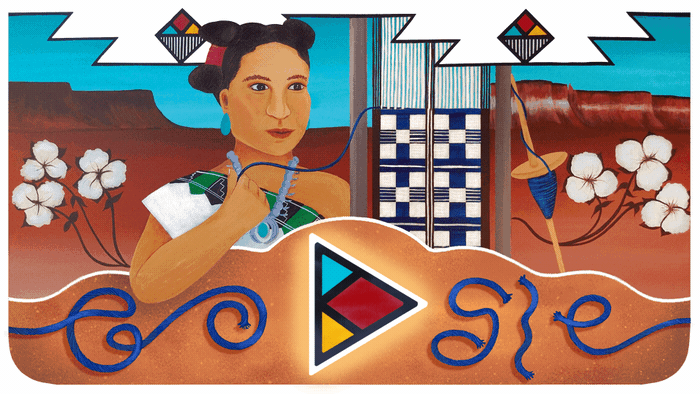
In celebration of the beginning of Native American Heritage Month in the United States, Google has replaced their homepage logo with an interactive Doodle for We:wa, a member of the Zuni tribe, weaver, and ambassador to the United States on behalf of Native Americans in general.
Life of We:wa of the Zuni people
We:wa — sometimes stylized “We’wha” — was born within the state of New Mexico in 1849, as a part of the Zuni people. That same year, the Zuni people began openly engaging with the American people. Unfortunately, this led to tragedy as the American colonists brought smallpox with them, which ultimately killed both of We:wa’s parents.
Part of Zuni culture is the role of Łamana — sometimes stylized “lhamana” — a person assigned male at birth who instead takes on the societal and domestic duties traditionally reserved for females, including cooking, cornmeal grinding, and pottery. While typically Łamana are recognized very early on in childhood, We:wa was treated as a Zuni boy, not being recognized as Łamana until their teenage years. As a distinguishing trait, the Łamana will often wear a mixture of masculine and feminine clothing.
In 1864, We:wa’s adoptive family moved, along with other families, to other Zuni lands to become farmers. In contrast to their more feminine role to that point, by farming, We:wa was at the time taking on a more masculine role. Around 10 years later, with We:wa’s new mother growing older, they took on more of the feminine duties to help the family.
Sometime in We:wa’s thirties, Christian missionaries began living among the Zuni people as part of an effort to integrate the tribe into American living, particularly through religious education. We:wa spent time with the minister who was sent to the tribe, Dr. Taylor Ealy, and his wife to help attend to their daughters.
In addition to being an accomplished potter, by that time We:wa had spent many years practicing the craft of weaving clothes, and they created clothes for the Ealy’s. Their eye for colors and patterns made We:wa’s dresses and baskets quite desirable.
Around this same time, We:wa met the anthropologist Matilda Coxe Stevenson, who was eager to meet such a member of the Zuni people who was willing to learn English to share knowledge between the Americans and the Zuni tribe. Over time, the two formed a friendship, with Stevenson teaching We:wa how to wash clothes with America’s stronger laundry soap. This skill lent itself well to many paid positions including washing clothes for the nearby Fort Wingate.
Much of what was known about the Zuni people at that time stemmed from the friendship shared between Stevenson and We:wa. Stevenson even commissioned from them some traditional Zuni pottery — a religious process in and of itself — to be displayed in a museum.
Later, in 1886, the first ever delegation of the Zuni people, including We:wa, went to Washington D.C., where they met President Grover Cleveland. However, after tensions between the Americans and the Zuni people, We:wa and other tribe leaders were arrested and held in prison for a month. We:wa died of heart failure in 1896 at age 47.
We:wa Google Doodle

To best celebrate We:wa’s life, Google has created a fun mini-game that walks you through the process of weaving cloth into patterns. As you craft each gradually more complex pattern, you’re also given an educational tidbit about We:wa and the Zuni people.
The artwork of the Doodle — including the colorful portrait of We:wa themself — was created by Zuni Pueblo guest artist Mallery Quetawki. Over on the Google Doodle blog, Quetawki shared some insight into the process she went through in learning the history before helping create this Doodle.
I was very fortunate to accompany our keepers of traditional knowledge to Washington D.C. a couple years ago to visit the Smithsonian Museum of the American Indian. […] I was able to learn directly from our religious leaders and cultural keepers of knowledge of the items in that museum collection. I have kept that knowledge with me, as well as the research I had done on We:wa in a college course describing the dual gender roles that can be seen in our tribe. The very few photos of We:wa were not the only images I used to create the portrait. I made sure I included the character that We:wa was both in social and cultural contexts.
— Mallery Quetawki
More Google Doodles:
- Google Doodle honors Claude Cahun, photographer, author, and provocateur
- Google Doodle honors Helena Modrzejewska, Polish Shakespearean performer
- Google Doodle honors marine biologist María de los Ángeles Alvariño González
Author: Kyle Bradshaw
Source: 9TO5Google



